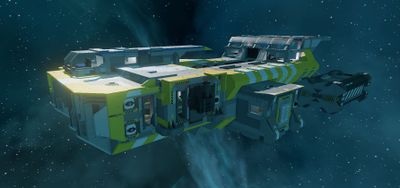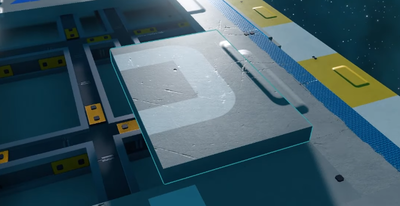Spaceship Engineering
Summary
This page details the required processes to create or modify a spaceship in Starbase.
Ships generally can be constructed ingame by manually bolting ingame objects and components together, or by manufacturing directly to a predefined blueprint. Alternatively if a player has no desire to design their own ship, a ship can also be bought from the in game economy, either directly from a player, or from a Capital Mega Station.
The ship construction process can be described simply as follows:
- Mine raw resources from asteroids
- Refine raw resources into usable Materials and metals.
- Print/Build resources into Devices / Parts.
- Bolt together Beam parts into a usable Frame.
- Bolt onto frame additional components And Devices.
- Link required devices to power/propellant and add control devices, Command Centre, FCU etc.
Component/Device Production
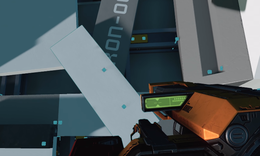
All ships are created from components and devices, most, if not all physical objects in the gameworld can be 'bolted' together using the Bolt tool.
Materials
All Spaceships are created from refined materials collected from asteroids or harvested from other ships/wrecks within the universe.
Raw minerals are distributed throughout the universe within player mineable asteroids. Materials and minerals will vary in distribution and usefulness, with rare minerals being used for more expensive and critical elements of ships, such as the MFC/FCU (Flight control unit).
Players can mine these resources through the use of a hand Pickaxe, or a Mining laser
Refining
Materials will require pre processing in order to be useful to a player, this can be done by simply selling minerals, or refining them using large refinery devices, commonly found on any of the 5 initial Capital Mega Stations that populate the universe.
Component / Part Printing
Components and devices that are usable must be first printed from refined materials into physical objects in the game world. For example a player refines a material, this material can then be used to print Beams, armour plates, door sections, etc,
Components are printed as whole sections, which can be stored as physical objects or in cargo containers.
Basic Construction
Components in the world are primarily assembled by bolting components together using the Bolt tool, usually this starts with a superstructure constructed from modular beams which forms the basic frame, and onto which can be bolted armour panels and devices.
Ship Design
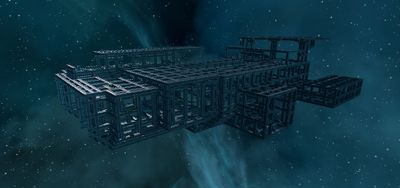
All ships need 4 key things to be able to function:
- Power & Generation
- Thrusters & Fuel
- Superstructure/Frame
- A method of controlling The Ship such as a Command Centre or Lever etc
In addition you will need armour plating and various devices to add defence, weaponry and other assorted functionality to a ship. After construction a ship can be examined in-game using the Durability tool to test for key flaws in a design.
Superstructure / Frame
All ships require a rigid superstructure, this acts as a frame and a basis from which a ships structural strength is derived. A Ships superstructure is composed of I-Beams printed from materials, which are then bolted together using the bolt tool or a ship mounted bolting device.
Since all structural strength is derived from a superstructure, it is important that it be designed in a way that supports the ship, overpowered thrusters on a flimsy superstructure will tear apart a ship, and a ship without adequate support would be prone to structural damage.
All structural stability of a design can be related to structural integrity.
Armour Plating
Armour plating is the defensive skin that covers the superstructure frame of the ship. Armour plating provides internal components and the superstructure protection from space and weapons damage, although it is not critical to the ships ability to fly.
Armour plating is fabricated in shaped sheets or sections which can then be bolted to a ships frame to add aesthetic contour and defence in critical locations to mitigate various types of weapons and environmental damage. Plating can be bolted in any location, assuming it has a valid location to be bolted, thus it can be used for both external and internal defence and decoration.
Ship Power
All ships require power created from a Generator device. All devices that require power require themselves to be connected to a generator by connecting them with blue wires, which can be custom placed throughout the ship with the cable tool. If at any point power connection is severed the connected component or device will cease to function.
Ship generators are not simple plug and play devices, and can use a whole host of additional addon-devices that facilitate it's function, a user must be careful to ensure that generators have:
- Modules for cooling / heat dispersion
- Sockets for attaching power cables to
- Fuel rods (for fuel)
Thrusters/Thrust
Thrusters are devices that provide the main driving force of a spaceship in flight. Every ship requires thrusters to fly in space and provide motion in all axis for the spaceship. Thrusters require both power from a generator and Propellant from propellant tanks to be able to function. The exact amount of propellant required depends on the thruster type.
A resource called Propellant is consumed by thrusters when being used, and is stored in tanks within the ship. Every thruster needs directly or indirectly piping to a propellant tank to facilitate its use, connected through use of the Pipe tool. Cessation of a fuel line will cause a thruster to cease functioning.
Most ships requires multiple small maneuvering thrusters in all directions, this provides a ship the ability to turn and point itself when travelling.
In Starbase all thrusters apply a torque around the centre of mass, thus for the most efficient designs thrust should be balanced and equally distributed as much as possible.
MFC/FCU (Flight control unit)
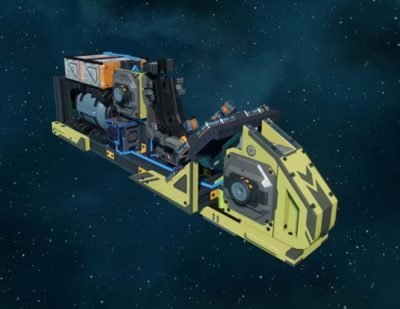
The 'Main Flight Computer'(MFC) and 'Flight Control Unit'(FCU) are expensive devices used to 'balance' a ship.
For example in a ship which has offset thrusters, or has damaged thrusters on one side of the ship, under normal circumstances accelerating will cause the ship to spiral out of control.
FCU'and MFC's come in the form of small boxes, and can usually be easily identified on a build. All FCU's will take input from various control means and route into a central MFC (connected via wires) which combines information from several FCU's and sends data to the thrusters in order to balance them. The FCU/MFC will throttle each thruster such that forces around the center of mass are balanced and thus when accelerating even if the ship is off balance or has battle damage, will not spiral out of control and be easily flyable, even when subject to battle damage.
Being expensive components that have such a high importance they are a great component to be looted or targeted, and should thus be kept heavily defended.
Additional Devices
Additional Devices on a ship refers to the many additional components that can be attached to a ship that provide it with it's additional functionality. Devices include but are not limited to: Weapons, mechanical blocks such as doors, generators, control seats, mining equipment etc. Devices require themselves to be connected to power and usually fastened to the superstructure, as with armour plating.
Critical out of these is a controlling device that facilitates a characters ability to interface with and control a ship, This can be in the form of directional levers or buttons around the ship, or in a command centre or bridge.
In addition most devices have some form of access to the ingame programming language YOLOL, which ultimately allows automation of processes and streamlining of ship systems for enhanced functionality.
